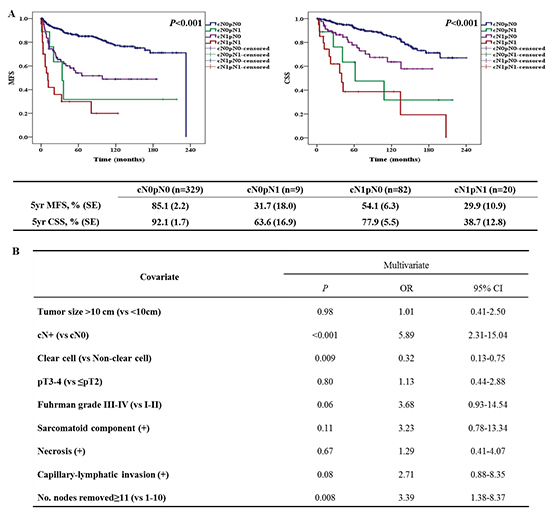1. Pantuck AJ, Zisman A, Dorey F, Chao DH, Han KR, Said J, Gitlitz BJ, Figlin RA, Belldegrun AS. Renal cell carcinoma with retroperitoneal lymph nodes: role of lymph node dissection. J Urol. 2003; 169:2076–2083.
2. Delacroix SE Jr, Chapin BF, Chen JJ, Nogueras-Gonzalez GM, Tamboli P, Matin SF, Wood CG. Can a durable disease-free survival be achieved with surgical resection in patients with pathological node positive renal cell carcinoma? J Urol. 2011; 186:1236–1241.
3. Karakiewicz PI, Trinh QD, Bhojani N, Bensalah K, Salomon L, de la Taille A, Tostain J, Cindolo L, Altieri V, Ficarra V, et al. Renal cell carcinoma with nodal metastases in the absence of distant metastatic disease: prognostic indicators of disease-specific survival. Eur Urol. 2007; 51:1616–1624.
4. Canfield SE, Kamat AM, Sánchez-Ortiz RF, Detry M, Swanson DA, Wood CG. Renal cell carcinoma with nodal metastases in the absence of distant metastatic disease (clinical stage TxN1-2M0): the impact of aggressive surgical resection on patient outcome. J Urol. 2006; 175:864–869.
5. Kane CJ, Mallin K, Ritchey J, Cooperberg MR, Carroll PR. Renal cell cancer stage migration: analysis of the National Cancer Data Base. Cancer. 2008; 113:78–83.
6. Leibovich BC, Blute ML. Lymph node dissection in the management of renal cell carcinoma. Urol Clin North Am. 2008; 35:673–678. viii
7. Crispen PL, Breau RH, Allmer C, Lohse CM, Cheville JC, Leibovich BC, Blute ML. Lymph node dissection at the time of radical nephrectomy for high-risk clear cell renal cell carcinoma: indications and recommendations for surgical templates. Eur Urol. 2011; 59:18–23.
8. Capitanio U, Abdollah F, Matloob R, Suardi N, Castiglione F, Di Trapani E, Capogrosso P, Gallina A, Dell'Oglio P, Briganti A, et al. When to perform lymph node dissection in patients with renal cell carcinoma: a novel approach to the preoperative assessment of risk of lymph node invasion at surgery and of lymph node progression during follow-up. BJU Int. 2013; 112:E59–E66.
9. Hutterer GC, Patard JJ, Perrotte P, Ionescu C, de La Taille A, Salomon L, Verhoest G, Tostain J, Cindolo L, Ficarra V, et al. Patients with renal cell carcinoma nodal metastases can be accurately identified: external validation of a new nomogram. Int J Cancer. 2007; 121:2556–2561.
10. Studer UE, Scherz S, Scheidegger J, Kraft R, Sonntag R, Ackermann D, Zingg EJ. Enlargement of regional lymph nodes in renal cell carcinoma is often not due to metastases. J Urol. 1990; 144:243–245.
11. Studer UE, Birkhäuser FD. Lymphadenectomy combined with radical nephrectomy: to do or not to do? Eur Urol. 2009; 55:35–37.
12. Türkvatan A, Akdur PO, Altinel M, Olçer T, Turhan N, Cumhur T, Akinci S, Ozkul F. Preoperative staging of renal cell carcinoma with multidetector CT. Diagn Interv Radiol. 2009; 15:22–30.
13. Van Poppel H. Lymph node dissection is not obsolete in clinically node-negative renal cell carcinoma patients. Eur Urol. 2011; 59:24–25.
14. Edge SB. American Joint Committee on Cancer. AJCC cancer staging manual. 7th ed. New York, NY: Springer;2010.
15. Eisenberg MS, Cheville JC, Thompson RH, Kaushik D, Lohse CM, Boorjian SA, Costello BA, Leibovich BC. Association of microvascular and capillary-lymphatic invasion with outcome in patients with renal cell carcinoma. J Urol. 2013; 190:37–43.
16. Kates M, Lavery HJ, Brajtbord J, Samadi D, Palese MA. Decreasing rates of lymph node dissection during radical nephrectomy for renal cell carcinoma. Ann Surg Oncol. 2012; 19:2693–2699.
17. Sun M, Bianchi M, Hansen J, Abdollah F, Trinh QD, Lughezzani G, Shariat SF, Montorsi F, Perrotte P, Karakiewicz PI. Nodal involvement at nephrectomy is associated with worse survival: a stage-for-stage and grade-for-grade analysis. Int J Urol. 2013; 20:372–380.
18. Ming X, Ningshu L, Hanzhong L, Zhongming H, Tonghua L. Value of frozen section analysis of enlarged lymph nodes during radical nephrectomy for renal cell carcinoma. Urology. 2009; 74:364–368.
19. Thompson RH, Raj GV, Leibovich BC, Russo P, Blute ML, Kattan MW. Preoperative nomogram to predict positive lymph nodes during nephrectomy for renal cell carcinoma. J Urol. 2008; 179:212.
20. Delacroix SE Jr, Chapin BF, Wood CG. The role of lymph node dissection in renal cell carcinoma. Urol Clin North Am. 2011; 38:419–428. vi
21. Babaian KN, Kim DY, Kenney PA, Wood CG Jr, Wong J, Sanchez C, Fang JE, Gerber JA, Didic A, Wahab A, et al. Preoperative predictors of pathological lymph node metastasis in patients with renal cell carcinoma undergoing retroperitoneal lymph node dissection. J Urol. 2015; 193:1101–1107.
22. Blute ML, Leibovich BC, Cheville JC, Lohse CM, Zincke H. A protocol for performing extended lymph node dissection using primary tumor pathological features for patients treated with radical nephrectomy for clear cell renal cell carcinoma. J Urol. 2004; 172:465–469.
23. Russo P. Renal cell carcinoma: presentation, staging, and surgical treatment. Semin Oncol. 2000; 27:160–176.
24. Whitson JM, Harris CR, Reese AC, Meng MV. Lymphadenectomy improves survival of patients with renal cell carcinoma and nodal metastases. J Urol. 2011; 185:1615–1620.
25. Capitanio U, Suardi N, Matloob R, Abdollah F, Castiglione F, Briganti A, Carenzi C, Roscigno M, Montorsi F, Bertini R. Staging lymphadenectomy in renal cell carcinoma must be extended: a sensitivity curve analysis. BJU Int. 2013; 111:412–418.
26. Chapman TN, Sharma S, Zhang S, Wong MK, Kim HL. Laparoscopic lymph node dissection in clinically node-negative patients undergoing laparoscopic nephrectomy for renal carcinoma. Urology. 2008; 71:287–291.










 PDF
PDF ePub
ePub Citation
Citation Print
Print




 XML Download
XML Download